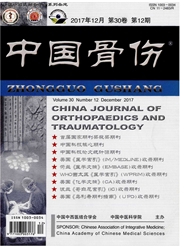

 中文摘要:
中文摘要:
目的:研究x线平片对椎体旋转诊断的应用价值。方法:自2010年5月至2011年6月收集颈椎病患者129例,行颈椎X线正位平片检查,其中119例存在棘突不共线纳入测量,另10例棘突均共线不纳入测量。纳入测量病例中男28例,女91例,年龄24—65岁,平均(48.53±14.32)岁。纳入病例行CT检查,记录X线平片中观察到的棘突不居中的椎体节段及个数,再对棘突不居中的椎体节段行CT后多平面重建,观测相应节段椎体旋转及棘突偏歪的情况,统计分析X线平片检查中观测到的不居中的棘突个数与椎体旋转之间的关系。结果:不共线棘突个数为1-6个时,椎体旋转率分别为45.45%,46.67%,56.86%,62.07%,77.14%,85.19%。结论:不共线棘突数越多,相应椎体旋转可能性越大。
 英文摘要:
英文摘要:
Objective:To analyze value of X-ray in diagnosis of cervical vertebral rotation. Methods:From May 2010 to June 2011,129 patients with cervical spondylosis were collected and examined by X-ray. Among them, 119 cases were collinear spinous, other 10 cases were excluded with collinear. Of involved patients, 28 cases were male, 91 eases were females with an average age of (48.53±14.32) (ranged,24 to 65) years. The segments and numbers of vertebral body spinous process which were not centered were recorded, and then CT scan was performed to examine segments of vertebral body and spinous process which were not centered to observe rotation of cervical vertebra and spinous process deviation. The relationship between numbers of spinous not centered and vertebral rotation was statistical analyzed. Results: When the number of spinous not centered ranged from 1 to 6, vertebral rotation rate were 45.45%, 46.67%, 56.86%, 62.07 %, 77.14%, 85.19% respectively. Conclusion: The more numbers of vertebral spinous process not centered, the more chance of corresponding vertebral rotation.
 同期刊论文项目
同期刊论文项目
 同项目期刊论文
同项目期刊论文
 Integrative TCM Conservative Therapy for Low Back Pain due to Lumbar Disc Herniation: A Randomized C
Integrative TCM Conservative Therapy for Low Back Pain due to Lumbar Disc Herniation: A Randomized C 期刊信息
期刊信息
